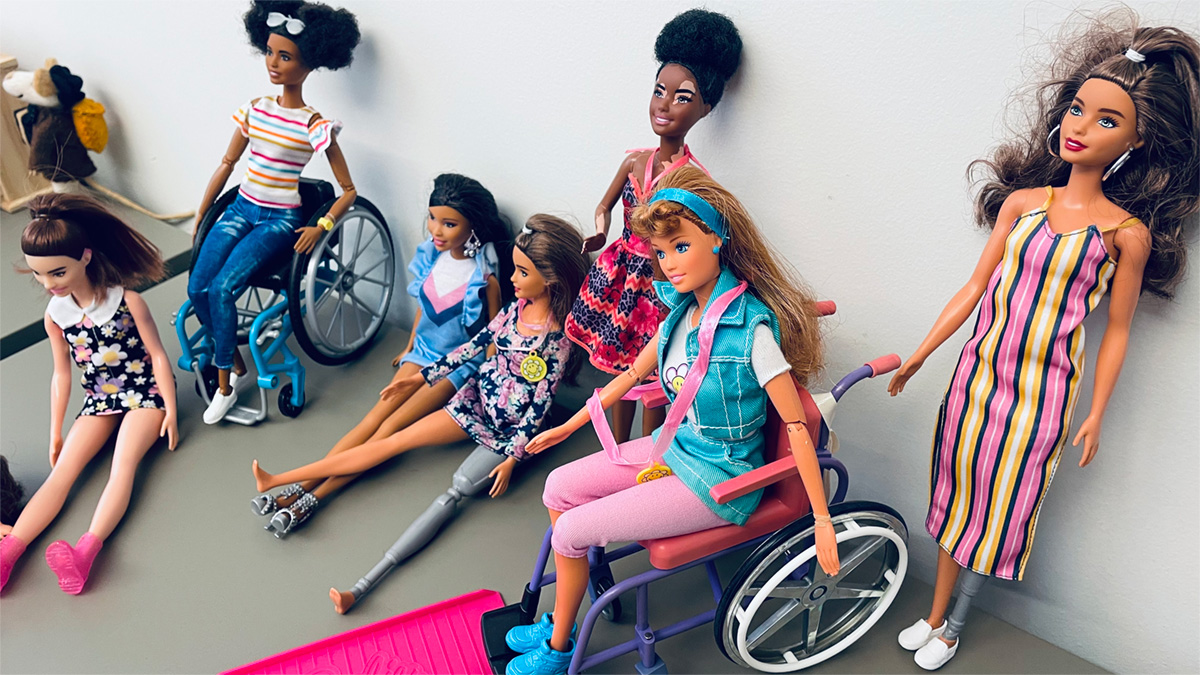Inclusion goes to the heart of what DREDF is all about. Access. Inclusion. Justice. Representation connects with inclusion, and when our experiences broaden and we embrace diversity (of race, disability, gender, sexuality, and age) more consistently, that diverse expression becomes what is the default – it’s to be expected! For too long, media and toys usually centered around white, non-disabled, cisgender people. The “default” representation is shifting as inclusion widens and the market power of diverse and authentic representation is recognized.
Barbie – a ubiquitous doll of idealized white mainstream beauty – has evolved to harness the power of diversity. The doll line has expanded to include Barbies with different skin colors and hair textures, and Barbies with a wide array of jobs. Barbies that celebrate mindfulness and yoga. Barbie’s path to disability inclusion has been a bumpy one.
Barbies with Disabilities
“Share a Smile Becky” was released in 1997. Becky is Barbie’s white, wheelchair-using friend. In 1998, School Photographer Becky (also a wheelchair user) was released then in 1999, Becky the Paralympic came out. None of the Becky’s were able to access Barbie’s house, toys, cars, or related gear. Whether or not it was because Mattel would need to make all of Barbie’s world accessible to accommodate the Becky’s, or for other reasons, the company quit producing them. No further progress in the disability arena was made by Mattel until 2019 with the introduction of the Barbie Fashionistas line.
With the advent of the Fashionistas line, a new wheelchair using Barbie was introduced as well as a prosthetic leg wearing Barbie. This time, however, the wheelchair that Barbie uses comes with a Barbie DreamHouse-compatible ramp!
The Fashionista line has gradually been expanded over the years to include a Barbie who wears behind-the-ear hearing aids as well as a Ken with vitiligo. Most recently, the Fashionista line has created a Barbie with Down syndrome.
Barbie with Down syndrome
This past week, Mattel released a Barbie with Down syndrome that is supposed to be a symbol of inclusion and representation that celebrates diversity. It is hoped that doll lovers with Down syndrome will feel empowered by seeing themselves represented, and will spread the fact that disability is a natural and normal part of the human experience to those who do not yet have a disability themselves.
Diverse Barbie dolls are important. They increase the visibility of disability and create a more inclusive world for people with disabilities. But who is playing with the dolls? Are these dolls only being played with by people with the same disabilities? Are brown dolls only being played with by brown children? Or are only dolls that are white being enjoyed across diverse lines? Do children without Down syndrome reach for Barbie with Down syndrome?
The power of inclusivity and integration includes life at the doll level: are the disabled Barbies stored on the top shelf at Target, just slightly out of reach, and with the cheaper (and hence, less desirable) price tag? Do they wear the slightly less attractive clothes, and with limbs that are not jointed, or are they actually as attractive and as fun to play with as the non-disabled and usually white dolls? Where is the inclusion stopping?
Barbie and Inclusion
It is gratifying to see the progress in Barbie’s representation of disability and diversity, but these doll lines will never be truly successful in their mission until we see a complete integration into the Barbie world. Until this happens, we must continue to push for full inclusion and reach out to ensure that all children – including those with disabilities – can have access to play with Barbies who are truly representative of our communities.
It is clear that the inclusion and representation of disability in the world of toys is steadily progressing, and the new Barbie with Down Syndrome doll is one more step towards creating an inclusive universe for all children. With a greater understanding of diversity




